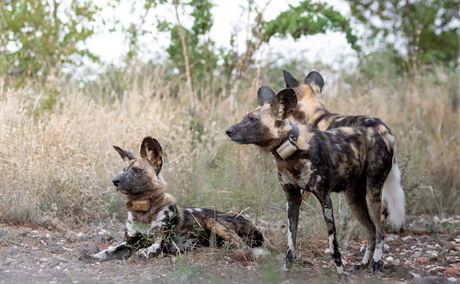Sometimes, you’re just in the right place at exactly the right time. That was the case on one unforgettable morning at Klaserie Drift—an experience that will stay with both our guides and guests forever. Keep reading to get the full story!
Leopards of Klaserie Drift

Over the years, our guides have had the luxury of getting to know many of the different leopards that call our part of the Klaserie home. Whilst some grow and move on to pastures new, others stay and thrive along our stunning section of the Klaserie River, even raising the next generation of fabulous felines right on our doorstep. Following their stories and learning about each individual character is a fascinating aspect of our guides' work. Here we share a little about just some of the incredible leopards that are currently found at Klaserie Drift.
Saseka
Born in the local area over 6 years ago, Saseka (meaning ‘pretty’) has been a firm favourite since the beginning. With patience and skill, she quickly became well accustomed to vehicles and now, so relaxed in our presence, she barely acknowledges us as we approach.
Over the imparting years, Saseka has grown into the most beautiful leopard, matching her name perfectly. Her territory has migrated from a local dam as a young female, and now centres around a dense scrub section in the south east of our traverse. However, she is known for her tendency to range far beyond her normal bounds. She has learnt from many mistakes - losing kills to hyena and lion and even being chased into a tree by wild dogs more than once - not to mention on two separate occasions she has sustained severe leg injuries, leaving her limping for some time. Thankfully, her inner strength pulled her through these challenging times.
Two and half years ago, the whole team was overjoyed to discover Saseka with two tiny, yet highly anticipated cubs. A first-time mom, she gifted us a brief moment of bliss before leading her charges away into the bush. Sadly, to add further to this female’s hardship, the cubs were never seen again. However, time and again we have marvelled at her amazing ability to recover from every set-back and so we wait expectantly for her next foray into motherhood. If there was one word to describe this captivating female, it is resilience.
Manzi

One of our more mature female leopards, Manzi is estimated to be at least 8 years old. Her territory has moved over the years, from the Klaserie Drift bridge and island area, to the section of river in the north of our traverse. Named after the water that she loves to patrol, this female is the epitome of calm and strength. Well-habituated to the vehicles and as smart as whip, she has even been witnessed stalking her prey out in the open, using our game viewers to hide behind and conceal her from her intended prey.
Roughly 5 years ago she had a litter of two cubs who, despite surviving their first few months, unfortunately failed to make it through their first tumultuous year. Undeterred, Manzi had another litter a year later. Of the 3, only one brave female survived - Xivindzi. Fast forward to today and this incredible mother is now raising two healthy cubs - a one-year-old male and female, thriving under mom's now experienced care. Unofficially dubbed the “queen of the Klaserie”, this regal feline makes life at the top look effortless.
Xivindzi

Eldest daughter of Manzi, Xivindzi’s name means “brave” or “courageous”. As the only cub to survive a litter of 3, this female not only defied the odds, but grew into the most charismatic and charming of all the Klaserie cats. At peace with our game viewers even as a cub, she has an innate curiosity, coupled with her mother’s calmness, that makes her completely beguiling to watch. Now roughly two and a half, Xivindzi has been fully independent for almost a year and currently likes to roam the area adjacent to Manzi’s core territory - a typical behaviour for young females - as well as the ridges right behind Misava lodge. She has been spotted with her father on many occasions recently, leading us to believe she was attempting to court him (not uncommon although not ideal!) Luckily, she shouldn’t be ready to conceive just yet.
Pale Male

The indomitable Pale Male. This magnificent male - named after his pale colour - has been the undisputed king of leopards as far back as local residents and guides can remember, putting him at possibly 12 years of age or more. Likely the father to all of the cubs (and even some of the adults) in the area, the Pale Male has sired a dynasty that will live on for many generations to come. As cool as a cucumber, yet stacked with attitude, sightings of him are always thrilling. We have seen other large males literally quiver and run in his powerful wake (you may notice the lack of other males in this list) and many a guide has accidentally called him in as a lioness on the radio! This boy is truly a legend without measure.
Maribye

Newly independent daughter of the Island female, Maribye (pronounced Marieps) is close to 18 months old and an enchanting individual. Owing to her mother’s ardent shyness, there were few opportunities to habituate Maribye to our vehicles as a young cub. However, despite this, she has somehow shown an astounding confidence around the game viewers - allowing us to slowly become acquainted with her quiet nature. Just like Xivindzi, this female has stayed close to her mother’s territory and can currently be found most often on the ‘Island’ - right by Misava Camp. Still very young, we continue to tread carefully in sightings so as not to overwhelm her - something which is often rewarded with special moments in her presence.
Island female and Airstrip female
These two females, one the mother of Maribye and the other a small 3 year old, are both resident leopards on our property, centred around the island and airstrip areas respectively. However, their elusive temperaments mean sightings can be fleeting and, as such, less is known about their characters and story. By nature, leopards favour hiding in the shadows and avoiding detection. As such, there remain many unknown individuals that have thus far snuck under our radar - or simply aren’t seen frequently enough to identify. For us, this just adds to the mystery and marvel of these incredible cats - and makes us feel ever more grateful that we are blessed with some truly awesome leopards here in the Klaserie.
Words and photos by Emily Whiting
Further Reading
Elephants are some of the most iconic animals on the planet, and encountering them on safari is always a powerful moment. But beyond their size and presence lies a world of incredible adaptations that help them thrive in their environment. From their trunks to their toes, every part of an elephant has evolved to serve a specific purpose—and the results are nothing short of remarkable. Here are five fascinating facts about elephant...
Perhaps more than any other animal, the prehistoric-looking rhinoceros has become a beacon for the plight to save Africa’s endangered wildlife. But how well do you really know these iconic animals? Let’s dive in to some fun facts and fictions on rhinos. (Or, head to the bottom to read more about rhino conservation!)









Share This Post